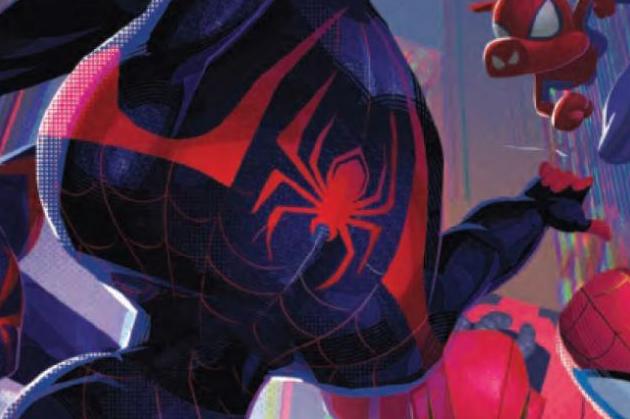Spider-Verse #1 Review
Writer: Jed MacKay
Artists & Colorists: Juan Frigeri & Carlos Lopez, Stacey Lee, Arthur Adams & Federico Blee, James Harren & Dave Stewart, Dike Ruan & Carlos Lopez, and Sheldon Vella
Letterer: Joe Sabino
Publisher: Marvel Comics
I’m not usually one to ride the high of movie synergy at Marvel, but when it comes to Into the Spider-Verse, I’m willing to give it a shot. But man, another Spider-Verse book? This has to be like, the fifth one this year. Hopefully, being so loosely based off the superior adaptation, it will get things right.
Nope. Listen, I don’t enjoy giving negative reviews here, even if I’ve been doing it a lot lately. This book’s not bad. It’s just not interesting. Nothing happens. Miles randomly hops around different worlds and then leaves before anything can happen. He shows up, asks “wHaT tHe HeCk Is GoInG oN?!”, and then leaves. There are no interesting developments in the worlds or their characters. Jed MacKay misses the mark in the very brief “character moment” (very heavy air quotes there) he gives Miles, when he questions why the “real” Spider-Man wasn’t called on to save the day. Did MacKay even see the movie? Hasn’t comic book Miles been past this for a long time? It comes across as either ignorant or a step back for Miles. I’m not sure which is worse.
The art fares much better in this story, but unfortunately, it’s not enough to save the issue. As you would expect, different creators offer a different tone to each world. They all feel very distinct from one another, but none of them really get room to breathe. It’s a shame this book didn’t have just a few more pages. That would have let the artists do some cool splash pages to change the pace and keep things fresh. The coloring is really solid across the board and is what really pushes the distinctive qualities of each world over the edge. In each style, the artists were clearly picked for their world for the right reason. In that regard, this book plays to its strengths very well.
Maybe this will read better in a trade, but as a stand-alone issue, Spider-Verse #1 did not do it for me. A first issue should never be so uneventful, and MacKay’s misunderstanding of Miles as a character is not doing anyone any favors. The art is at least good throughout, but none of the creators get room to spread their wings and strut their stuff. If you must, read it on Unlimited.
Artists & Colorists: Juan Frigeri & Carlos Lopez, Stacey Lee, Arthur Adams & Federico Blee, James Harren & Dave Stewart, Dike Ruan & Carlos Lopez, and Sheldon Vella
Letterer: Joe Sabino
Publisher: Marvel Comics
I’m not usually one to ride the high of movie synergy at Marvel, but when it comes to Into the Spider-Verse, I’m willing to give it a shot. But man, another Spider-Verse book? This has to be like, the fifth one this year. Hopefully, being so loosely based off the superior adaptation, it will get things right.
Nope. Listen, I don’t enjoy giving negative reviews here, even if I’ve been doing it a lot lately. This book’s not bad. It’s just not interesting. Nothing happens. Miles randomly hops around different worlds and then leaves before anything can happen. He shows up, asks “wHaT tHe HeCk Is GoInG oN?!”, and then leaves. There are no interesting developments in the worlds or their characters. Jed MacKay misses the mark in the very brief “character moment” (very heavy air quotes there) he gives Miles, when he questions why the “real” Spider-Man wasn’t called on to save the day. Did MacKay even see the movie? Hasn’t comic book Miles been past this for a long time? It comes across as either ignorant or a step back for Miles. I’m not sure which is worse.
The art fares much better in this story, but unfortunately, it’s not enough to save the issue. As you would expect, different creators offer a different tone to each world. They all feel very distinct from one another, but none of them really get room to breathe. It’s a shame this book didn’t have just a few more pages. That would have let the artists do some cool splash pages to change the pace and keep things fresh. The coloring is really solid across the board and is what really pushes the distinctive qualities of each world over the edge. In each style, the artists were clearly picked for their world for the right reason. In that regard, this book plays to its strengths very well.
Maybe this will read better in a trade, but as a stand-alone issue, Spider-Verse #1 did not do it for me. A first issue should never be so uneventful, and MacKay’s misunderstanding of Miles as a character is not doing anyone any favors. The art is at least good throughout, but none of the creators get room to spread their wings and strut their stuff. If you must, read it on Unlimited.





